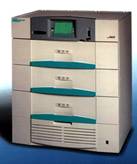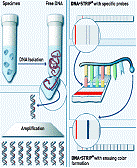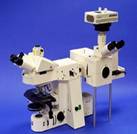The Laboratory of Microbiology and Morphology of tuberculosis
Equipments and methods of investigation:
|
BD ProbeTecTM
Isotermic amplification (SDA) in fluorescence and rapid detection
Major work efficiency- 564 results in 8 hours of work
Security in exploitation (close system)
Isotermic method
Simple in exploitation
The possibility of use by soft EpiCenter, LIS
|
 |
|
BACTEC MGIT 960
For multiplication and isolation of micobacterium
The test of the sensitiveness of M.tuberculosis towards the antituberculosis preparates of 1 and 2 line.
Absolute automatized system
Rapid results and non invaded fluorescent technology.
The results are obtained with a 2-3 bigger quickness than at the practiced method. |
 |
|
Molecular genetic test-system "Genotip MTBDR PLUS".
For rapid discovery of M.tuberculosis complex and the test of the resistance towards the Rifampicine and Isoniaside from the isolated strain or sputum specimen.
The "Genotip MTBDR plus" Hain test is a genetic molecular methodology of the test of M.tuberculosis sensitiveness, first of all for the multiresisting tuberculosis. The applied methodology is simple, safe, rapid, can be easily combined with other methodologies, and is applied in automatic or semiautomatic system. The test-system "Genotip MTBDR plus" allows to discover the pathogenic agent from pathological material and also to determine the resistance towards the Rifampicine and Isoniaside, strategical medicines in the treatment of tuberculosis. |
 |
|
The fluorescent microscopy for discovering the patients with tuberculosis.
The fluorescent microscopy for discovering the Micobacterium tuberculosis in sputum continues to be an express method of diagnosis of tuberculosis. This methodology is with 40% more sensible than the method of colouring of the frottis through Ziehl-Neelson method. The fluorescent microscopy with the colouring of the frottis with auramin- rodamin is simple in performing, is cheap, the result can be obtained in 3 hours. The fluorescent microscopy is used especially in biology, being the standard for the other types of microscopy.
|
 |
The performed services:
Microscopic examinations for discovering MBT from other pathological products – the simple microscopy, the fluorescent microscopy.
- Sowers on solid nutritious mediums for the separation of the pure cultures of M.tuberculosis.
- Sowers on liquid nutritious mediums for the separation of the pure cultures of M.tuberculosis through the method BACTEC MGIT 960.
- The identification of the isolated cultures of mycobacterium.
- The test of sensitiveness of M.tuberculosis towards the ant tuberculosis medicines of line 1.
- The test of sensitiveness of M.tuberculosis towards the ant tuberculosis medicines of line 2.
- The test of sensitiveness of M.tuberculosis towards the ant tuberculosis medicines of line 1 through the method BACTEC MGIT 960.
- The typification of the strains of no tuberculosis mycobacterium.
- The evidence and study of L-mycobacterium forms.
- Bacteriological investigations for the isolation of nonspecific flora and the determination of the pathogenic agent with the estimation of the sensitiveness.
- Bacteriological investigations for the discovery of the fungus flora.
- Cytological researches; Morph pathological investigations of diagnosis of the endoscopic biopsy material, of the biopsy material through puncture, incision, the enucleating of the pathological processes. The exfoliate cytology (the investigation of the atypical corpuscles as part of the prophylactic examination).





